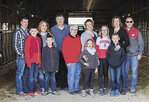FOX LAKE, Wis. – Kari Gribble and her brother, Nick Schultz, started buying back into their family farm in 2002. Their parents loaned them 10 cows, and the siblings paid them off as they sold the milk. It was important to have some skin in the game and abide by their parents’ rules of getting an education and working for somebody else before returning to the farm. In 2008, their sister, Katy Schultz, came back to farm full time and complete the trio.
“Succession planning has always been part of our business model,” Gribble said. “We work under a parallel business model with separate financials. This model allowed us to shrink one side and grow the other side, which provided some control to the speed at which we were transitioning those assets. We originally started purchasing land from Mom and Dad and then realized this is very cost prohibitive. There are a lot of tax implications and capital gains, and we needed a better long-term strategy.”
Gribble and her siblings milk 500 cows and farm about 2,000 acres at Tri-Fecta Farms near Fox Lake. During an episode of a “Dairy Stream” podcast series examining farm succession planning, Gribble shared details of her family’s experience with farm transition, while Eric Gullicksrud, vice president of tax and accounting at Compeer Financial, offered words of wisdom pertaining to the financial aspect of transitions.
When asked what the first step is in analyzing the business financials of the succession plan, Gullicksrud said people need to figure out the needs of the retiring party, and existing debt has to be figured into their cash flow.
“Debt servicing becomes a large part of the total plan as we need to structure it so the business can continue to meet all of its cash flow needs,” Gullicksrud said. “The last thing we want is the new generation running into cash flow problems and asking Mom and Dad to take a lower payment.”
Tri-Fecta Farms came up with an asset plan four years ago which includes a living trust.
“This completely changed our business model,” Gribble said. “We no longer had to concentrate on accumulating cash for large down payments. It allowed us to be more strategic with our goals moving forward.”
An area that can catch families off guard is letting the next generation assume their debt.
“Several times I’ve seen parents deed the farm over and let the next generation assume the debt, not realizing the tax problems this can create,” Gullicksrud said. “It’s the same as Mom and Dad getting cash to pay off that debt, and a lot of times in real estate, it’s a very low tax basis.”
Gribble said having a comprehensive list of assets and liabilities and due dates is a good first step in analyzing the business financials of a farm’s succession plan.
“This process is going to be an investment, but spending money upfront to get things titled correctly could save you considerable money in the future,” she said.
When it comes to organizing a farm’s cash flow analysis, Gullicksrud likes to see at least three years of past income and expenses. From there, the next generation can build their future cash flows and see what it looks like having to take on the debt of buying out their parents.
“Typically, there are some tax consequences and that has to be figured into that cash flow as well,” Gullicksrud said. “That’s where the tax consulting side comes in to try to minimize that the best we can because any dollars leaving the operation is just less for that operation to work with.”
Tri-Fecta Farms uses QuickBooks which Gribble said provides good projection opportunities, allowing the user to create budgets and look at actual expenditures over a series of years.
“We have a pretty diversified business which means while we have the consistency of milk checks coming in, we also have the ability to tailor some of our cash crops and other forage sales during those peak times of cash needs, giving us a little more flexibility,” Gribble said.
When considering debt analysis, Gullicksrud recommends taking everything into account – not only the debt requirements but also family living requirements.
“Anything that’s going to take cash flow has to be figured in there,” he said. “A capital replacement, for example, is an easy one to forget, but things wear out and you need to figure that in. Try to have as extensive of a plan as you possibly can. It all starts with good sound records. You need that to have confidence in the plan you’ve put together.”
Gribble agreed.
“Sometimes, we lock in interest rate loans with a long-term fixed rate so we have a standard monthly amount we can control and be more aggressive in paying that off if we want to,” she said. “As Mom and Dad look to decrease their assets and as their equipment is nearing the end of its useful life, our business model allows us to buy new equipment, providing the opportunity to grow our side and decrease their side.”
Because interest rates are lower, Gullicksrud has seen a lot of parents going the land contract route rather than having the next generation go to another lender. When setting up a land contact, Gullicksrud said to make sure payments will be sufficient 10 or 20 years down the road to cover all the costs of retiring parents.
Gribble and her siblings used long-term loan programs as well as an operating line of credit to provide a cushion to see them through times of high cash needs as income fluctuated throughout the year. To minimize tax burdens and implications, Gribble recommends being proactive and seeking the advice of experts as well as setting up entities or trusts that allow for a smooth transition.
“There’s nothing more frustrating than having all this hard-earned money not benefiting the next generation because you’re paying it out in taxes,” she said.
Gullicksrud agreed.
“Working with a good tax professional is very important,” he said. “The tax code has gotten so complicated today that if you just look at total costs for having your return done versus all the things that can be taken for credits, deductions, you usually get what you pay for.”
He said depreciation recapture is the large one on the sale of machinery, single purpose buildings and purchased cows. In many cases, when parents are looking at doing some gifting, they will consider gifting these assets. Items to sell would be capital gain assets like bare land and raised dairy cows and beef cows. These assets can be sold in a contract, and taxes would be paid on the principal payments as they are received. Those payments can be spread out.
“Capital gains rates are the cheapest around compared to normal rates,” Gullicksrud said. “There are some real opportunities to set these sales up properly to make sure we’re minimizing tax dollars.”
Some of Gullicksrud’s clients do an annual gifting when transitioning the farm. For the last several years, that limit has been $15,000 per individual person but recently increased to $16,000. An in-law could also gift up to $16,000.
Another area to keep up with is Social Security. Gullicksrud recommends going on the Social Security website every couple years to request a statement to ensure proper earnings are being given. This helps in knowing what other sources of income a person will have to supplement their farm retirement sale. If a farmer wants to start drawing Social Security before full retirement age, they must be aware of earnings they can have without having to pay some of this money back again. For 2022, this limit is $19,560.
“My mom and dad worked side by side, but for a long time, Dad drew a much bigger salary than Mom so what she had set aside in Social Security was much less than him,” Gribble said. “Making sure they have enough to cover living expenses moving forward, we look at what other income sources they have.”
Gullicksrud said it is never too early to start planning for a transition.
“The sooner you start, the more options you’ll have when the time comes to start transitioning,” he said. “There is no transition boilerplate. Every transition is unique, and you have to tailor it to what works for you.”


Comments
No comments on this item Please log in to comment by clicking here